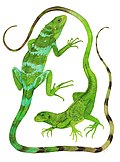
The Channel Islands are an eight-island archipelago located within the Southern California Bight in the Pacific Ocean, off the coast of California. They define the Santa Barbara Channel between the islands and the California mainland. The four Northern Channel Islands are part of the Transverse Ranges geologic province, and the four Southern Channel Islands are part of the Peninsular Ranges province. Five of the islands are within the Channel Islands National Park. The waters surrounding these islands make up Channel Islands National Marine Sanctuary. The Nature Conservancy was instrumental in establishing the Channel Islands National Marine Sanctuary.

Chuckwallas are lizards found primarily in arid regions of the southwestern United States and northern Mexico. Some are found on coastal islands. The five species of chuckwallas are all placed within the genus Sauromalus; they are part of the iguanid family, Iguanidae.

The ensatina is a species complex of plethodontid (lungless) salamanders found in coniferous forests, oak woodland and chaparral from British Columbia, through Washington, Oregon, across California, all the way down to Baja California in Mexico. The genus Ensatina originated approximately 21.5 million years ago. It is usually considered as monospecific, being represented by a single species, Ensatina eschscholtzii, with several subspecies forming a ring species.
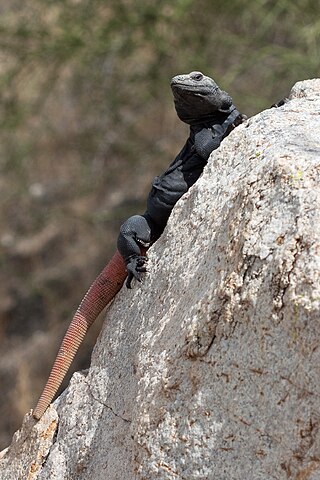
Sauromalus ater, also known as the common chuckwalla or northern chuckwalla, is a species of lizard in the family Iguanidae. It inhabits the Sonoran and Mojave Deserts of the Southwestern United States and northwestern Mexico. Its range extends from eastern California, Utah, and Nevada south to Baja California and Sonora.

Laurence Monroe Klauber, was an American herpetologist and the foremost authority on rattlesnakes. He was the first curator of reptiles and amphibians at the San Diego Natural History Museum and Consulting Curator of Reptiles for the San Diego Zoo. He was also a businessman, inventor, and contributed to mathematics in his study of the distribution of prime numbers.

The Santa Catalina rattlesnake is a species of pit viper endemic to Isla Santa Catalina in the Gulf of California just off the east coast of the state of Baja California Sur, Mexico. Like all other pit vipers, it is venomous. No subspecies are currently recognized. A relatively small and slender species, its most distinctive characteristic is that it lacks a rattle. They are also a generally nocturnal species. Though the species is classified as Critically Endangered on the IUCN Red List, there are few efforts for the snake's conservation.
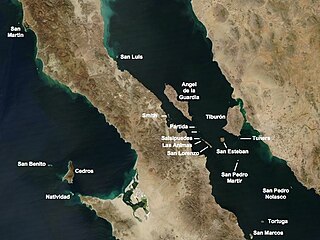
San Esteban Island is a small island in the Gulf of California, Mexico, located to the southwest of Tiburón Island. It is part of the Municipality of Hermosillo in Sonora and has a land area of 39.773 km2, the 15th-largest island in Mexico. It is located in the Gulf of California. It was once inhabited by a group of the Seri people.

Slevin's mouse, also known as the Catalina deer mouse, is a species of rodent in the family Cricetidae. It is endemic to Isla Santa Catalina off the east coast of Baja California Sur, an island with an area of about 40 km2 (15 sq mi), and it is the only native mammal on the island. It is named for Joseph Slevin, a curator at the California Academy of Sciences.
The spotted box turtle is a species of turtle in the family Emydidae. The species is endemic to the Sierra Madre Occidental in Mexico.
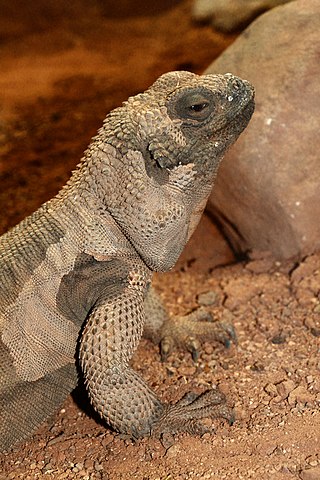
The Angel Island chuckwalla, also known as the spiny chuckwalla, is a species of chuckwalla lizard belonging to the family Iguanidae endemic to Isla Ángel de la Guarda in the Gulf of California. The species was transported to other islands by a tribe of the Seri as a potential food source.
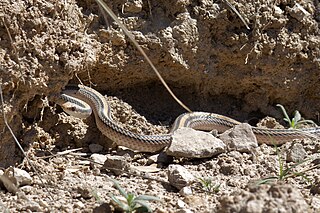
Salvadora hexalepis, the western patch-nosed snake, is a species of non-venomous colubrid snake, which is endemic to the southwestern United States and northern Mexico.

The San Esteban chuckwalla, also known as the piebald chuckwalla or pinto chuckwalla, is a species of chuckwalla belonging to the family Iguanidae endemic to San Esteban Island in the Gulf of California. It is the largest of the five species of chuckwallas, and the most threatened.
Sauromalus slevini, also known as the Monserrat chuckwalla or Slevin's chuckwalla, is a species of chuckwalla belonging to the family Iguanidae. S. slevini is native to three small islands in the Sea of Cortés.

Sphaerodactylus klauberi is a species of gecko, a lizard in the family Sphaerodactylidae The species is endemic to the archipelago of Puerto Rico.

Isla Coronados, is an island in the Gulf of California east of the Baja California Peninsula in Baja California Sur state, Mexico. The island is uninhabited and is part of the Loreto Municipality.
Isla Santa Cruz, is an island in the Gulf of California, east of the Baja California Peninsula in Baja California Sur state.
Isla San Lorenzo Sur, is an island in the Gulf of California east of the Baja California Peninsula. The island is uninhabited and is part of the Mexicali Municipality. Isla San Lorenzo Norte is located immediately northwest of Isla San Lorenzo Sur.
The northern spotted box turtle, also commonly known as Klauber's box turtle and Klauber's spotted box turtle, is a subspecies of turtle in the family Emydidae.
The Catalina Island leaf-toed gecko is a species of gecko. It is endemic to Isla Santa Catalina in Gulf of California, Mexico.
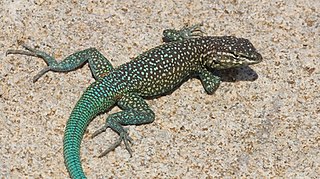
The Isla Santa Catalina side-blotched lizard is a species of lizard. It is endemic to Isla Santa Catalina in the Gulf of California, Mexico. This species of lizard can be as long as 2.2 inches.
















